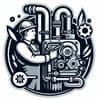Podcast
Questions and Answers
Which property of a material is primarily concerned with its ability to deform under tension?
Which property of a material is primarily concerned with its ability to deform under tension?
- Toughness
- Thermal conductivity
- Tensile strength (correct)
- Compressive strength
Which law describes the relationship between the force acting on an object and the object's motion?
Which law describes the relationship between the force acting on an object and the object's motion?
- Charles's Law
- Hooke's Law
- Ohm's Law
- Newton's Second Law (correct)
In terms of material properties, which characteristic provides information on how a material will respond to heat?
In terms of material properties, which characteristic provides information on how a material will respond to heat?
- Elasticity
- Thermal expansion (correct)
- Ductility
- Yield strength
Which of the following describes a scenario where a structure oscillates at its natural frequency?
Which of the following describes a scenario where a structure oscillates at its natural frequency?
What effect do damping forces have on a vibrating system?
What effect do damping forces have on a vibrating system?
Which statement accurately describes the Third Law of Thermodynamics?
Which statement accurately describes the Third Law of Thermodynamics?
How is the continuity equation significant in fluid mechanics?
How is the continuity equation significant in fluid mechanics?
Which of these is a key characteristic of turbulent flow?
Which of these is a key characteristic of turbulent flow?
What is a primary property of polymers as a category of materials?
What is a primary property of polymers as a category of materials?
In Bernoulli’s Equation, which term accounts for the kinetic energy of the fluid?
In Bernoulli’s Equation, which term accounts for the kinetic energy of the fluid?
In the context of mechanical design, why is load analysis critical?
In the context of mechanical design, why is load analysis critical?
What is the significance of safety factors in mechanical design?
What is the significance of safety factors in mechanical design?
Which characteristic is typical of metals as a material category?
Which characteristic is typical of metals as a material category?
Flashcards are hidden until you start studying
Study Notes
Thermodynamics
-
Laws of Thermodynamics:
- Zeroth Law: Thermal equilibrium and temperature.
- First Law: Energy conservation (ΔU = Q - W).
- Second Law: Entropy increases in an isolated system; heat cannot spontaneously flow from cold to hot.
- Third Law: As temperature approaches absolute zero, entropy approaches a constant minimum.
-
Key Concepts:
- Heat Transfer: Conduction, convection, and radiation.
- Thermal Cycles: Carnot cycle, Rankine cycle, and refrigeration cycles.
- State Functions: Pressure, volume, temperature, and internal energy.
Fluid Mechanics
-
Fundamental Principles:
- Continuity Equation: Conservation of mass (A1V1 = A2V2).
- Bernoulli’s Equation: Energy conservation in a flowing fluid (P + ½ρv² + ρgh = constant).
-
Flow Types:
- Laminar Flow: Smooth and orderly, characterized by low Reynolds numbers.
- Turbulent Flow: Chaotic and irregular, characterized by high Reynolds numbers.
-
Key Concepts:
- Viscosity: Measure of a fluid's resistance to deformation.
- Hydrostatics: Study of fluids at rest, including pressure variations with depth.
Mechanical Design
-
Design Process:
- Define problem, conceptual design, detailed design, testing, and implementation.
-
Key Elements:
- Load Analysis: Identify loads acting on the component (static, dynamic).
- Material Selection: Consider strength, weight, cost, and availability.
- Safety Factors: Design with margins to account for uncertainties.
-
Design Tools:
- CAD software: For modeling and simulation.
- Finite Element Analysis (FEA): For stress and strain analysis.
Materials Science
-
Material Categories:
- Metals: High strength, ductility (e.g., steel, aluminum).
- Polymers: Lightweight, corrosion-resistant (e.g., plastics).
- Ceramics: High hardness, brittleness (e.g., porcelain).
- Composites: Combination of materials for enhanced properties (e.g., fiberglass).
-
Key Concepts:
- Material Properties: Mechanical (tensile strength, toughness), thermal, electrical.
- Phase Diagrams: Understanding material states (solid, liquid, gas) and transitions.
Dynamics and Vibrations
-
Dynamics:
- Newton's Laws: Governing motion and forces.
- Kinematics: Describes the motion of objects (displacement, velocity, acceleration).
-
Vibrations:
- Types of Vibrations: Free, forced, and damped vibrations.
- Natural Frequency: Frequency at which a system oscillates without external force.
-
Key Concepts:
- Damping: Reduction of amplitude over time due to energy loss.
- Modal Analysis: Study of the dynamic characteristics of structures.
These notes provide a concise overview of key concepts in each subtopic within the field of Mechanical Engineering.
Thermodynamics
- Laws of Thermodynamics encompass essential principles governing energy and heat:
- Zeroth Law establishes the concept of temperature through thermal equilibrium.
- First Law asserts energy conservation within a system, represented by the equation ΔU = Q - W.
- Second Law indicates that in isolated systems, entropy tends to increase, and heat cannot flow spontaneously from colder to hotter regions.
- Third Law suggests that as temperature nears absolute zero, the entropy of a perfect crystal approaches a minimum constant.
- Heat Transfer occurs via three mechanisms:
- Conduction: heat transfer through direct contact.
- Convection: heat transfer through fluid movement.
- Radiation: transfer of energy through electromagnetic waves.
- Thermal Cycles include:
- Carnot cycle: theoretical maximum efficiency cycle.
- Rankine cycle: heat engine cycle using steam.
- Refrigeration cycles: processes to remove heat from a designated area.
- State Functions are properties defining the state of a system:
- Key examples include pressure, volume, temperature, and internal energy.
Fluid Mechanics
- Fundamental Principles dictate fluid behavior:
- Continuity Equation states mass conservation in flowing fluids: A1V1 = A2V2.
- Bernoulli’s Equation expresses energy conservation in fluid flow: P + ½ρv² + ρgh = constant.
- Flow Types are categorized based on characteristics:
- Laminar Flow: smooth and orderly, featured in low Reynolds numbers.
- Turbulent Flow: chaotic and irregular behavior present in high Reynolds numbers.
- Key Concepts in fluid mechanics include:
- Viscosity: a fluid's resistance to deformation and flow.
- Hydrostatics: the study of fluids at rest and the pressure changes with depth.
Mechanical Design
- Design Process involves several stages:
- Identifying the problem, followed by conceptual and detailed design phases, and ending with testing and implementation.
- Key Elements essential for effective design include:
- Load Analysis: determining static or dynamic loads impacting components.
- Material Selection: evaluating factors such as strength, weight, cost, and availability of materials.
- Safety Factors: incorporating margins into designs to mitigate uncertainties.
- Design Tools utilized in mechanical engineering:
- CAD Software: allows for accurate modeling and simulation of designs.
- Finite Element Analysis (FEA): used to assess stress and strain on components.
Materials Science
- Material Categories are classified by their properties:
- Metals: known for strength and ductility, examples include steel and aluminum.
- Polymers: valued for lightweight and corrosion resistance, commonly seen in plastics.
- Ceramics: characterized by high hardness yet brittleness, such as porcelain.
- Composites: materials made from two or more constituent materials, e.g., fiberglass, enhancing overall properties.
- Key Concepts encompass:
- Material Properties: involve mechanical properties like tensile strength and toughness, as well as thermal and electrical properties.
- Phase Diagrams: illustrations showing material states (solid, liquid, gas) and their transitions.
Dynamics and Vibrations
- Dynamics is studied through:
- Newton's Laws: fundamental laws describing motion and force interactions.
- Kinematics focuses on the motion of objects in terms of displacement, velocity, and acceleration.
- Vibrations are classified into various types:
- Free Vibrations: occur without external influence.
- Forced Vibrations: result from external forces acting on a system.
- Damped Vibrations: exhibit amplitude reductions over time due to energy dissipation.
- Natural Frequency refers to the inherent frequency at which a system oscillates in absence of external force.
- Key Concepts related to vibrations include:
- Damping: the process that reduces movement amplitude over time.
- Modal Analysis: a technique to evaluate the dynamic characteristics of structures.
Studying That Suits You
Use AI to generate personalized quizzes and flashcards to suit your learning preferences.




